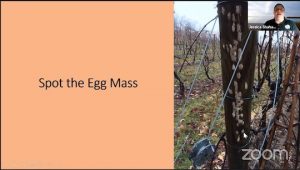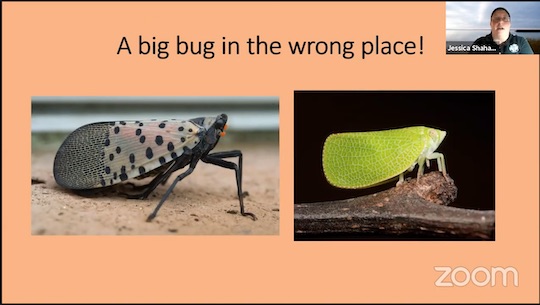Scrape, Squash, and Stop spotted lanternflies was the theme behind a Tuesday night community meeting in Concord Township Tuesday night.
Jessica Shahan, a naturalist at Newlin Grist Mill, is responsible for the park's Environmental Education and Habitat Management Programs. One of the park's jobs is to make sure the natural flora and fauna are healthy, but the spotted lanternfly can interfere with that. The insect came to the United States seven to nine years ago as eggs on a pallet of material from China, it's believed.
"A spotted lanternfly is basically a big bug that's in the wrong place," Shahan said. "They feed on plants by piercing the tissues with long poky mouthparts and sucking out the juices. They then secrete a substance called 'honeydew.' It's the excess water and nutrient sugars that they're not using from those plants."

She added that just because it's harming plants here in Pennsylvania doesn't mean it's a bad bug.
"The problem is that we, as humans, have moved this bug from where it's supposed to be, where it has natural predators, and where plant systems have evolved to deal with the honeydew, to a place where the predators have no idea what this is and there are no natural controls on its population. That's why we get the large population booms and a lot more damage here than back in China or Vietnam," Shahan said.
She added, though, "They're really gorgeous insects, and if it weren't for the bad bug reputation, I think they'd get a lot more love than they do."
Southeastern Pennsylvania has a significant lanternfly population. Their primary mode of travel is to hop from plant to plant, but they do hitchhike on products being shipped, and even on people, Shahan said. "Their primary way of moving is through human activities."
While the lanternfly doesn't bite, the problem is two-fold. One part is what she referred to as "density-dependent feeding," where once they find a plant they like to eat, every insect in the area swarms to that plant and devastates it. The plant or tree can be covered with hundreds to thousands of insects. The tree becames dehydrated and nutrient deficient. And once the bark is penetrated, the tree is prone to diseases and susceptible to other pests.
The honeydew that the insects secrete makes the problem worse because, "The tree is basically covered in sugar," where molds and fungus grow.
"And that can multiply up the food chain. If that tree dies, the bird that depends on its fruit, berries or nectar is out of a food source."
What to do
One thing that can help control the lanternfly is to find a tree in the area known as the Ailanthus Tree, more commonly known as the tree of heaven. It's a decorative tree brought to the U.S. from China about 100 years ago, and it provides a natural habitat for the lanternfly, both for food and for egg-laying. Controlling the Ailanthus Tree will help control the lanternfly.

Another thing to do is make sure your home and property aren't hospitable to the lanternfly. And the primary way is to make sure you have no Ailanthus Trees on your property, and the best way to do that is with an herbicide anytime green leaves are present, she said.
Property owners can also scrape off egg masses before they hatch. Use some alcohol=based hand sanitizer, a baggie or jar, and something to use as a scraper.
"Put some sanitizer in the bag, scrape the egg mass directly into the alcohol, and the eggs will die," she said. "It's super easy, and you don't have to chase bugs around."
During May through August, keep an eye on what you bring onto your property, making sure there are no egg masses. The lanternfly is known to lay eggs on old tires and has laid them on old basketballs and even gardening hats.
Shahan advises not to use sticky traps, but other homemade traps are helpful. A circle trap can be used similar to a roadside cattle chute that funnels the insects as they crawl up a tree into a collecting device, such as a jar or plastic bag. (Check out the Penn State extension website on how to make a circle trap.
Shahan's full hour-long presentation can be found on the Concord Township YouTube channel.
About Rich Schwartzman
Rich Schwartzman has been reporting on events in the greater Chadds Ford area since September 2001 when he became the founding editor of The Chadds Ford Post. In April 2009 he became managing editor of ChaddsFordLive. He is also an award-winning photographer.


 (3 votes, average: 4.67 out of 5)
(3 votes, average: 4.67 out of 5)

Comments